
Eriogonum fasciculatum is a species of wild buckwheat known by the common names California buckwheat and flat-topped buckwheat. Characterized by small, white and pink flower clusters that give off a cottony effect, this species grows variably from a patchy mat to a wide shrub, with the flowers turning a rusty color after blooming. This plant is of great benefit across its various habitats, providing an important food resource for a diversity of insect and mammal species. It also provides numerous ecosystem services for humans, including erosion control, post-fire mitigation, increases in crop yields when planted in hedgerows, and high habitat restoration value.
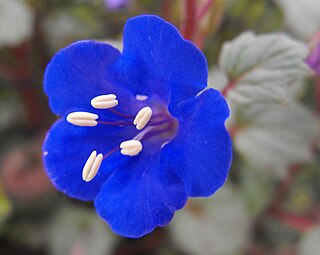
Phacelia campanularia is a species of flowering plant in the borage family, Boraginaceae, known by the common names desertbells, desert bluebells, California-bluebell, desert scorpionweed, and desert Canterbury bells. Its true native range is within the borders of California, in the Mojave and Sonoran Deserts, but it is commonly cultivated as an ornamental plant and it can be found growing elsewhere as an introduced species.

Cerastium glomeratum is a species of flowering plant in the family Caryophyllaceae known by the common names sticky mouse-ear chickweed and clammy chickweed. It is native to Europe, Macaronesia to Assam but is known on most continents as an introduced species. It grows in many types of habitat. The blooming period is February, March, April, and May.
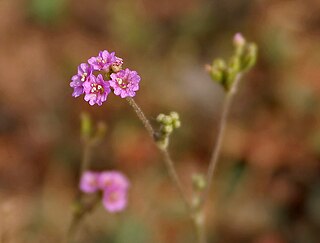
Boerhavia is a genus of over 100 species in the Nyctaginaceae family. The genus was named for Herman Boerhaave, a Dutch botanist, and the genus name is frequently misspelled "Boerhaavia". Common names include spiderlings and hogweeds.

Triteleia crocea, with the common names yellow triteleia and yellow tripletlily, is a monocot flowering plant in the genus Triteleia.

Sambucus racemosa is a species of elderberry known by the common names red elderberry and red-berried elder.

Astragalus bernardinus, known by the common name San Bernardino milkvetch or the Lesser Three-keeled Milkvetch, is a species of milkvetch. It is a plant of desert and dry mountain slope habitat. It is native to California.

Astragalus pycnostachyus is a species of milkvetch known by the common name marsh milkvetch. It is endemic to the coastline of California, where it grows in wet saline habitat such as marshes.

Boerhavia coccinea is a species of flowering plant in the four o'clock family which is known by many common names, including tar vinescarlet spiderling and red boerhavia.

Boerhavia coulteri is a species of flowering plant in the four o'clock family known by the common name Coulter's spiderling. It is native to the southwestern United States and northern Mexico, particularly the desert areas. This is an annual herb producing an erect or creeping stem up to about 70 or 80 centimeters in maximum length. They are slightly hairy and have sticky resin glands toward the bases. The leaves are lance-shaped to somewhat triangular, pointed, sometimes wavy or rippled along the edges, and 5 centimeters in maximum length. Most of the leaves grow from the lower half of the plant. The sticky inflorescence is a small cluster of tiny white to pale pink flowers, each under two millimeters long. The fruit is an elliptical body a few millimeters in length with longitudinal ribs. The fruits are borne in small clusters.
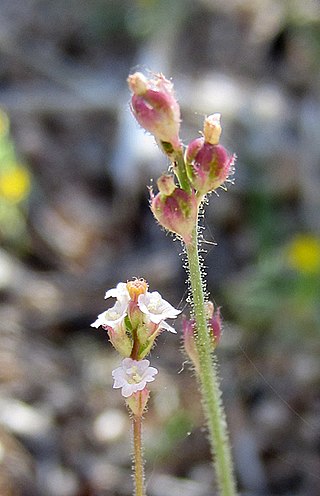
Boerhavia wrightii is a species of flowering plant in the four o'clock family known by the common name largebract spiderling. It is native to the deserts of the southwestern United States and northern Mexico, where it grows amongst desert shrubs. This is an annual herb producing a slender, spidery erect stem to about 70 centimeters in maximum length. The leaves are lance-shaped to oblong with rippled edges and roughly pointed ends. Most of the leaves grow near the base of the plant. The inflorescences appear at the ends of the slim stem branches. They bear a few pale pink flowers, each just a few millimeters long, with adjacent reddish or pinkish bracts.
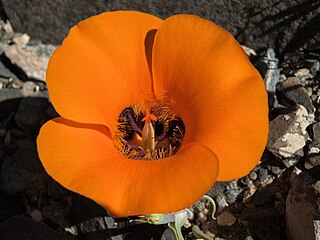
Calochortus kennedyi is a North American species of flowering plant in the lily family known by the common name desert mariposa lily.
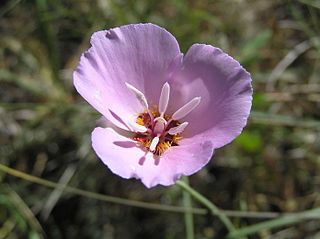
Calochortus palmeri is a species of flowering plant in the lily family known by the common names Palmer's mariposa lily and strangling mariposa.

Calycadenia multiglandulosa is a species of flowering plant in the family Asteraceae, known by the common names sticky calycadenia and sticky western rosinweed. It is endemic to California, where it is a common in the Coast Ranges and in the Sierra Nevada Foothills from Shasta County to Kern County.

Boerhavia diffusa is a species of flowering plant in the four o'clock family which is commonly known as punarnava, red spiderling, spreading hogweed, or tarvine. It is taken in herbal medicine for pain relief and other uses. The leaves of Boerhavia diffusa are often used as a green vegetable in many parts of India.

Palafoxia arida is a species of flowering plant in the aster family, known by the common names desert palafox and Spanish needle.
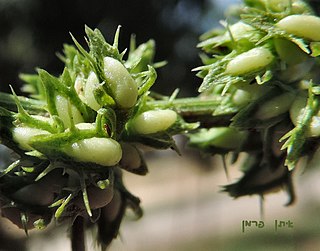
Rumex dentatus is a species of flowering plant in the knotweed family known by the common names toothed dock and Aegean dock. It is native to parts of Eurasia and North Africa, and it is widely known elsewhere as an introduced species. It grows in disturbed habitat, often in moist areas, such as lakeshores and the edges of cultivated fields. It is an annual or biennial herb producing a slender, erect stem up to 70 or 80 centimeters in maximum height. The leaves are lance-shaped to oval with slightly wavy edges, growing to a maximum length around 12 centimeters. The inflorescence is an interrupted series of clusters of flowers, with 10 to 20 flowers per cluster and each flower hanging on a pedicel. Each flower has usually six tepals, the 3 inner of which are edged with spinelike teeth and have tubercles at their centers.

Boerhavia erecta, commonly known as the erect spiderling or the erect boerhavia, is one of more than 100 species in the genus Boerhavia L. Boerhavia erecta is native to the United States, Mexico, Central America, Angola and western South America, but now is cosmopolitan in tropical and subtropical regions. In Africa its distribution extends from West Africa, eastwards to Somalia and down to South Africa. It has recently been found in parts of Madagascar and Réunion. In Asia, it occurs in India, Java, Malaysia, the Philippines, China and the Ryukyu Islands.
Boerhavia gracillima, the slimstalk spiderling, is a plant species native to Arizona, New Mexico, Texas and Mexico. It prefers dry, rocky areas such as grasslands, desert scrub, roadsides and pinyon-juniper woodlands.

Drymocallis glandulosa, formerly Potentilla glandulosa, known by the common names Douglas' wood beauty and sticky cinquefoil, is a plant species in the family Rosaceae.




















